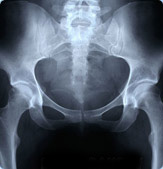Hip Pain Treatment

The two bones that come together to create your hip are the femur (the large bone in your thigh that's also considered part of your knee) and the pelvis.
The top part of your femur (the femoral head) is shaped like a ball and it fits into the round socket on the side of your pelvis (the acetabulum). So, like your shoulder, your hip is a true ball-and-socket joint - a design that allows for the wide range of motion necessary for daily activities (e.g., walking).
The femoral neck attaches the femoral head to the rest of the femur. And the part of the femur that juts outward (you can feel the bump on side of your hip) is the greater trochanter. Large muscles, including the gluteus medius, connect to the greater trochanter and keep your pelvis stable as you walk.
There are also several important ligaments in your hip. Ligaments are soft tissue structures that connect bones to other bones, hold them in place and provide stability. Like your shoulder, a special type of ligament (a ring of fibrous cartilage) forms a unique structure inside the hip called the labrum. The labrum creates a deeper cup for the acetabulum socket. When this small rim of cartilage is injured, it can be very painful and cause "clicking" in the hip.
In fact, problems with the joint are often the cause of hip pain. You will feel this type of pain on the inside of your hip or in your groin area. But the muscles, ligaments, tendons and other structures that support your hip joint can also be the root of hip pain. You will feel pain associated with these components on the outside of your hip or the upper thigh. Diseases and conditions in other areas of your body can even cause hip pain. Physicians refer to this as "referred pain."
The following are common hip injuries.
- Hip Pain From Groin Injury
- Hip fFexor Strain From Overuse
- Hip Joint Dysfunction
- Hip Labrum Tear or Labral Tear
- Hip Replacement Physical Therapy
- Iliotibial Band Syndrome (ITBS)
- Osteoarthritis or Arthritis
- Femoroacetabular Impingement (FAI)
- Post-Surgical Rehab/Physical Therapy
- Sciatica / Piriformus Syndrome
- Slipped Disc or Herniated Disc
- Snapping Hip - Iliopsoas Syndrome
- Iliopsoas Tendonitis:Acute Trauma & Overuse
- Trochanteric Bursitis or Hip Bursitis
When to Seek Help
An inability to walk comfortably, hip pain at night, unable to bend or swelling of the hip or the thigh area, is a pretty good indication that it's time to see a pain specialist, before your condition worsens.
Before discussing your symptoms with a doctor, it may be helpful to review some common conditions.
Why Should I See a Physiatrist?
Physiatrists are uniquely qualified to diagnose and treat musculoskeletal pain and injury because it's the focus of their education and training. Physiatrists complete four years of medical school, plus an additional four years of residency training, and many go on to complete fellowships in various specialties. In order to become a board-certified physiatrist, physicians must then pass comprehensive tests (oral and written) administered by the American Board of Physical Medicine and Rehabilitation (ABPM&R) or the American Osteopathic Board of Physical Medicine and Rehabilitation (AOBPM&R). Physiatrists will assess your condition, needs and expectations thoroughly and develop a tailor-made treatment regimen.
Take the Next Step
PATIENT SUCCESS
TOP 10 REASONS to Visit a Physiatrist
- 1. Physiatry is a medical specialty
- 2. Physiatrists are medical doctors (M.D.s and D.O.s)
- 3. Physiatrists treat the whole person, not just a condition
- 4. Physiatrists use the latest treatments and modalities
- 5. No problem is ever too small or too big for a physiatrist
- 6. Physiatry treatment is highly individualized to meet the specific needs of the patient
- 7. Physiatry can often help people avoid surgery
- 8. The physiatrist's job is restore as much function and independence as possible—to put the pieces of people's lives back together
- 9. The physiatrist works with a team of health care professionals that includes physicians of other medical specialties, and therapists
- 10. Physiatrists can help with acute and chronic pain management issues

